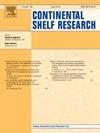Contrasting diversity patterns using Autonomous Reef Monitoring Structures deployed in pelagic vs. benthic environments
IF 2.2
3区 地球科学
Q2 OCEANOGRAPHY
引用次数: 0
Abstract
Recent developments of data-driven standardized sampling tools have reduced knowledge gaps on benthic biodiversity and larval dispersal patterns. Here, we present a new application to estimate benthic spatial biodiversity patterns and evaluate potential larval dispersal from nearshore coast to the pelagic environment. To do so, we combined DNA metabarcoding and imagery on Autonomous Reef Monitoring Structures (ARMS) deployed in pelagic and nearshore benthic systems across the Bay of Biscay's Basque Coast. Results reveal a remarkably lower biodiversity in pelagic relative to benthic ARMS as well as strong spatial patterns in community composition with the pelagic ARMS greatly differing to the benthic ones according to both metabarcoding (ANOSIM R = 0.82; p = 0.002) and image analysis (ANOSIM R = 0.87; p = 0.001). We also show that a large portion of the larvae inhabiting the pelagic domain (83.5%) probably originates from benthic habitats, while the benthic community shared across pelagic and benthic habitats is considerably lower (24.9%). Further, we also analyzed which benthic species successfully use the pelagic environment to disperse across the ocean from nearshore coast, and found that the unique benthic taxa inhabiting the pelagic ARMS consist of organisms with typically larger dispersal distances relative to strictly sessile taxa with direct larvae development found only in rock-attached benthic ARMS. Overall, these findings suggest that the benthic system acts as population source delivering species towards a less diverse pelagic domain. Taken together, this novel application of ARMS deployed in pelagic systems has the potential to identify the often overlooked yet critically important benthic community structure, as well as to unveil how dispersal pathways across benthic and pelagic habitats can shape biodiversity patterns of coastal ecosystems.
利用部署在远洋和底栖环境中的自主珊瑚礁监测结构对比多样性模式
数据驱动的标准化采样工具的最新发展缩小了关于底栖生物多样性和幼虫扩散模式的知识差距。在这里,我们提出了一种新的应用来估计底栖生物空间多样性格局和评估潜在的幼虫从近岸海岸到远洋环境的扩散。为此,我们将DNA元条形码和自主珊瑚礁监测结构(ARMS)的图像结合起来,这些结构部署在比斯开湾巴斯克海岸的远洋和近岸底栖生物系统中。结果表明,与底栖生物群落相比,中上层生物群落的生物多样性明显较低,群落组成的空间格局较强,中上层生物群落与底栖生物群落差异较大(ANOSIM R = 0.82;p = 0.002)和图像分析(ANOSIM R = 0.87;p = 0.001)。研究还表明,栖息在上层域的大部分幼虫(83.5%)可能来自底栖生物栖息地,而在上层和底栖生物栖息地共享的底栖生物群落则相当低(24.9%)。此外,我们还分析了哪些底栖物种成功地利用远洋环境从近岸海岸扩散到海洋,发现栖息在远洋ARMS的独特底栖类群是由相对于严格无底栖类群的生物组成的,它们的扩散距离通常更大,而直接幼虫发育只在附着岩石的底栖ARMS中发现。总的来说,这些发现表明,底栖生物系统作为种群来源,向多样性较低的远洋领域输送物种。综上所述,在远洋系统中部署的这种新型ARMS应用有可能确定经常被忽视但至关重要的底栖生物群落结构,并揭示底栖生物和远洋栖息地的扩散途径如何影响沿海生态系统的生物多样性模式。
本文章由计算机程序翻译,如有差异,请以英文原文为准。
求助全文
约1分钟内获得全文
求助全文
来源期刊

Continental Shelf Research
地学-海洋学
CiteScore
4.30
自引率
4.30%
发文量
136
审稿时长
6.1 months
期刊介绍:
Continental Shelf Research publishes articles dealing with the biological, chemical, geological and physical oceanography of the shallow marine environment, from coastal and estuarine waters out to the shelf break. The continental shelf is a critical environment within the land-ocean continuum, and many processes, functions and problems in the continental shelf are driven by terrestrial inputs transported through the rivers and estuaries to the coastal and continental shelf areas. Manuscripts that deal with these topics must make a clear link to the continental shelf. Examples of research areas include:
Physical sedimentology and geomorphology
Geochemistry of the coastal ocean (inorganic and organic)
Marine environment and anthropogenic effects
Interaction of physical dynamics with natural and manmade shoreline features
Benthic, phytoplankton and zooplankton ecology
Coastal water and sediment quality, and ecosystem health
Benthic-pelagic coupling (physical and biogeochemical)
Interactions between physical dynamics (waves, currents, mixing, etc.) and biogeochemical cycles
Estuarine, coastal and shelf sea modelling and process studies.
 求助内容:
求助内容: 应助结果提醒方式:
应助结果提醒方式:


